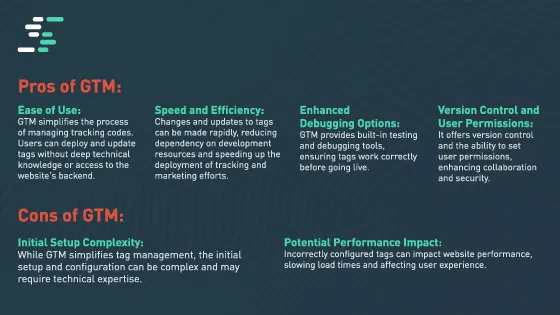In the rapidly evolving digital analytics landscape, Google Analytics 4 (GA4) and Google Tag Manager (GTM) emerge as quintessential tools for marketers, webmasters, and analysts. Each serves a unique purpose in tracking, analyzing, and optimizing businesses’ online presence.
However, their functions often overlap, leading to confusion about when and how to use them effectively. This blog post aims to demystify GA4 and GTM by comparing and contrasting their functions, analyzing their pros and cons, and elucidating when they should be used in tandem.
Understanding Google Analytics 4 (GA4)
Google Analytics 4 represents a significant evolution from its predecessor, Universal Analytics. Designed for a privacy-first, cross-platform world, GA4 focuses on user engagement and integrates seamlessly across websites and apps, providing a more comprehensive view of user interactions.
GA4 came out in 2020, but many people continued using Universal Analytics. That changed in July 2023, when UA stopped being supported for many customers. The remaining UA users will lose access to it in July 2024. This means it is more important than ever to learn and understand Google Analytics 4.
To better understand GA4, let’s take a look at the pros and cons of using it.

Pros of GA4:
- Event-driven Data Model: Unlike Universal Analytics, which relied heavily on sessions and pageviews, GA4 uses an event-driven model, offering flexibility in tracking and measuring interactions beyond mere page loads.
- Cross-platform Tracking: GA4 excels in tracking user journeys across multiple platforms (websites, apps), enabling a unified view of the customer journey.
- Enhanced Privacy Features: With increasing concerns over user privacy, GA4 offers features such as data deletion and consent mode, aligning with global privacy regulations.
- Predictive Analytics: GA4 leverages machine learning to predict future actions users might take, such as potential revenue from specific customer segments.
Cons of GA4:
- Steep Learning Curve: Transitioning from Universal Analytics to GA4 can be challenging for many, given its completely different interface and data model.
- Limited Historical Data: For new GA4 properties, historical data accumulation starts from the point of creation, potentially leaving gaps in trend analysis.
- Complex Setup for Advanced Tracking: Custom events and conversions may require a deeper understanding of the platform and possibly custom coding.
Exploring Google Tag Manager (GTM)
Google Tag Manager operates as a tag management system, allowing users to update tags and code snippets on a website or mobile app, such as those used for traffic analysis and marketing optimization, without altering the underlying codebase. GTM came out in 2012 and fundamentally changed the way Tags were handled.
Before GTM, developers had to code tags manually. This led to many issues as the process was slow and prone to errors. GTM gave marketing teams much more independence and the ability to manage tags with a user-friendly interface.
With all that said, nothing is perfect, and neither is GTM. Let’s look at the pros and cons of using Google Tag Manager.
Pros of GTM:
- Ease of Use: GTM simplifies the process of managing tracking codes. Users can deploy and update tags without deep technical knowledge or access to the website’s backend.
- Speed and Efficiency: Changes and updates to tags can be made rapidly, reducing dependency on development resources and speeding up the deployment of tracking and marketing efforts.
- Enhanced Debugging Options: GTM provides built-in testing and debugging tools, ensuring tags work correctly before going live.
- Version Control and User Permissions: It offers version control and the ability to set user permissions, enhancing collaboration and security.
Cons of GTM:
- Initial Setup Complexity: While GTM simplifies tag management, the initial setup and configuration can be complex and may require technical expertise.
- Potential Performance Impact: Incorrectly configured tags can impact website performance, slowing load times and affecting user experience.
When to Use GA4 and GTM Together
The integration between Google Tag Manager (GTM) and Google Analytics 4 (GA4) presents several areas of overlap, particularly in data collection, event tracking, and user behavior analysis. Both tools are designed to work seamlessly together, offering marketers and analysts comprehensive insights into user interactions.
Understanding where GTM and GA4 intersect can help users leverage the strengths of both platforms more effectively:
- User Properties and Segmentation: GA4’s focus on user properties and segmentation can be enhanced through GTM. Information about users, such as device type, geographical location, or custom properties, can be collected and passed to GA4 via GTM. This shared focus on understanding and segmenting the audience allows for more targeted analysis and personalization efforts.
- Event Tracking and Configuration: Both GTM and GA4 strongly emphasize event-based data collection. GA4’s shift to an event-driven data model closely aligns with GTM’s capability to track custom events triggered by user interactions. This common ground allows for the seamless integration of event tracking across both platforms, where GTM can be used to define and manage the firing of events that are then analyzed within GA4.
- Data Layer Integration: The data layer is a critical component of GTM that allows for the structured and dynamic passing of information from the website to the tag management system. GA4 can utilize this data to enhance the tracking of user interactions, e-commerce activities, and more. The data layer bridges the website GTM and GA4, facilitating a more nuanced data collection and analysis process.
Utilizing GTM and GA4 Together
Understanding the overlapping capabilities of GTM and GA4 is just the beginning. The real power lies in using them in concert. For instance, GTM’s flexibility in deploying tags and setting up event tracking, with GA4’s analytical prowess and user-centric metrics, provides a comprehensive view of user behavior and site performance. This synergistic use of GTM and GA4 enables organizations to collect data more efficiently, analyze it more deeply, and act on insights more effectively.
In summary, the overlap between GTM and GA4 isn’t just about shared features or capabilities; it’s about creating a cohesive and powerful analytics framework. By leveraging the strengths of both platforms, users can achieve a level of insight and operational efficiency greater than the sum of its parts.
Whether through streamlined event tracking, enhanced data collection, or more accurate conversion measurement, integrating GTM and GA4 is a testament to the potential of collaborative digital analytics tools in driving data-driven decision-making.


